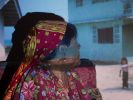Eye For Film >> Movies >> God Is A Woman (2023) Film Review
God Is A Woman
Reviewed by: Amber Wilkinson

Over the past few decades as the profile of documentaries has risen, they have also been shifting in form, with increasing numbers moving away from traditional structures. Thanks to changing attitudes and the democratisation of access to filming equipment courtesy of modern technology there’s also been a shift so that people from specific communities have been able to shape their own stories on film, rather than a God-like director simply offering their outsider opinion.
It hasn’t always been like this and Andres Peyrot’s emotionally rich and moving documentary brings the change home as his film about the Kuna people of Panama’s Kuna Yala archipelago enters into dialogue with a much older documentary that never saw the light of day. That film, God Is A Woman, was directed by Frenchman Pierre-Dominique Gaissea, who when he began to shoot the film in 1975 had already won an Oscar, in 1962, for Sky Above And Earth Beneath. Although Gaissea spent a year in the community with his wife and daughter Akiko, his film fell into financial difficulty and, subsequently, the hands of the bank.

Peyrot enters the story as university lecturer and writer Arysteides Turpana, who took part in Gaissea’s original film, is doing his best to find a copy of it so that he can bring it home to the community who never got to view it. It is not a spoiler to say that material from the film is found - as clips from it are shown from quite near the start of Peyrot’s film - but the story of how that comes about is an intriguing one that Peyrot captures.
Although it is about the importance of cultural heritage in many ways, this film is not one that seeks to lay out the finer details of the Kuna society. Tantalising snippets are offered, including bits of ceremonies and a re-enactment of revolutionary fighting, and some may find it frustrating that these are never explained. But if Peyrot jettisons historical specifics, presumably with the intention of letting the Kuna tell their own story on another occasion, he embraces bigger, more philosophical ideas.
One strand is the nature of Gaissea’s film, which saw him essentially invent his own narrative via narrative voice-over. Peyrot enters into lively dialogue with members of the community who took part in the original film and discovers that, among other things, Gaissea was carefully stage-managing things. In one instance, for example, he insisted those who brought plastic containers for use in a ritual were excluded from the footage in favour of those with more traditional carriers. It’s a small thing but one which emphasises the way that outsiders can view indigenous communities as, somehow, trapped in time rather than as living, breathing societies which, like anywhere else in the world, adopt new technologies and attitudes even as they are preserving their culture.
While the community view these introduced aspects with humour they also recognise the essential value of the film as a snapshot of life on the islands that should be preserved for future generations. This is just one of the ways in which Peyrot’s film embraces the imperfect ambiguities of documentary filmmaking and, for that matter, of life, and shies away from absolutism. After all, “You can be a filmmaker and a farmer,” as someone notes.
As we see the children of those who still live on the islands, but who haven’t been back for two decades, returning to view the film, Peyrot’s documentary becomes increasingly absorbing - so that we want to see this original film as much as they do. Watching the construction of a cinema screen for a community showing all adds to the warm emotional fabric of the film. A moment when Peyrot projects the original film over some of its subjects is also an inventive way of illustrating the dialogue between the present and the past. The reactions of the Kuna viewers as they watch the film are also affecting and, beyond the specific film itself, emphasise the importance of that essential place that may be geographically different for all of us but which we all know as home.
Reviewed on: 01 Sep 2023















